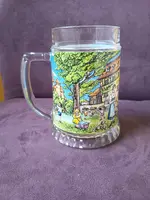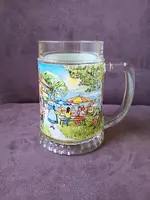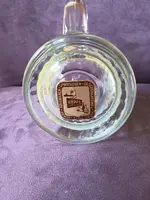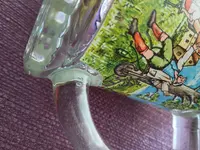Welcome to Tnet.
Yes, it would be called a stein, although traditionally they were made from stoneware pottery (“stein actually means “stone” in German), but the word now has a looser meaning for beer mugs in general.
It may well have been made in Munich, but the sticker is for the shop that sold it (Köppl), not the actual maker. It’s a relatively common German surname. The shop was located on the Rindermarkt, which is one of the oldest streets in Munich, and apparently sold süsswaren (confectionery), spirituosen (spirits) and geschenkartikel (gift items.)
I would put the date between about 1996 and 2010, based on two clues. In 1996, the “German orthography reform” specified that the use of the ‘eszett’ (ß) to represent a double ‘s’ after a long vowel should be replaced with the actual letters ‘ss’. So, before 1996, the word for confectionery would have commonly been written as “süßwaren” and from 1996 onwards as “süsswaren” (as on your stein). It’s not a hard and fast rule, since ‘ss’ was also sometimes used before 1996 on printed items if the font set happened not to have an ‘eszett’ character. Also, since there’s a six-digit telephone number, it can’t be after 2010 when Munich switched to ten-digit numbers. There doesn’t seem to be a shop of that name currently on the Rindermarkt.







